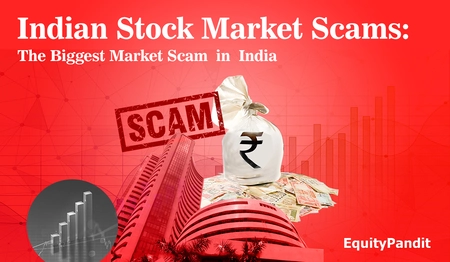The stock market is a land of fortune, where the right moves can make you rich. But what happens when the game is rigged? When fraudsters manipulate the system, turning dreams into dust overnight?
India’s biggest stock market scams aren’t just financial crimes—they’re shocking tales of deception, greed, and chaos. These scandals didn’t just cost money; they shattered trust and rewrote the rules of investing. Buckle up as we unravel the scams that rocked the market and changed it forever!
List of famous Stock Market Scam:
| Scam Name | Amount (in Rs. Cr.) | Year |
| Harshad Mehta Scam | 4,000 | 1992 |
| Ketan Parekh Scam | 1,000 | 2001 |
| Satyam Scam | 7,000 | 2009 |
| NSEL Scam | 5,600 | 2013 |
| Saradha Group Scam | 2,500 | 2013 |
Let’s dive right in, starting with the most infamous stock market scam of all time—the legendary Harshad Mehta Scam.
1. Harshad Mehta Scam (1992)
Harshad Mehta, famously known as the “Big Bull,” orchestrated one of India’s biggest stock market scams in 1992, siphoning off Rs 4,000 crore from banks to manipulate stock prices. His scheme created an artificial market boom that eventually collapsed, exposing deep flaws in the banking system and triggering a financial crisis.
Mehta exploited bank receipts (BRs) to secure funds from banks, diverting them into stocks listed on the Bombay Stock Exchange (BSE). As stock prices skyrocketed, everyday investors jumped in, unaware of the manipulation. But when the scam was exposed, the market crashed, wiping out investments and leading to major financial reforms. This remains one of the most talked-about share market scams in India.
2. Ketan Parekh Scam (2001)
Fast forward to the late 1990s, and another name made headlines—Ketan Parekh. He orchestrated a Rs 1,000 crore stock market scam by artificially inflating tech stock prices using borrowed funds. His pump-and-dump scheme fueled a market frenzy, but when it collapsed in 2001, it wiped out investors’ wealth and triggered a major market crash.
Parekh focused on high-risk stocks, particularly his K-10 shares—a set of companies he heavily invested in to manipulate prices. By continuously pumping money into these stocks, he created an illusion of demand, luring investors into the rally. However, once the bubble burst, stock prices plummeted, exposing the scam and leaving a lasting mark on India’s financial system.
3. Satyam Scam (2009)
In 2009, the corporate world was shaken when Ramalinga Raju, founder of Satyam Computers, confessed to faking Rs 7,000 crore in profits. This shocking revelation led to the collapse of one of India’s leading IT firms, forcing its sale to Tech Mahindra and highlighting severe lapses in corporate governance.
For years, Satyam’s management inflated financial statements, overstating assets, revenues, and profits to mislead investors. The fraud remained undetected for years, propping up the company’s stock price. Once exposed, the scandal not only shattered investor confidence but also led to stricter auditing standards to prevent such financial scams in India.
4. NSEL Scam (2013)
In 2013, the National Spot Exchange Ltd (NSEL) pulled off one of the biggest scams in India, defrauding investors of Rs 5,600 crore. Promoted by Jignesh Shah, NSEL lured investors with promises of high returns on commodity trades that never actually existed. When the system collapsed, it triggered Shah’s arrest and raised serious concerns about transparency in commodity trading.
The scam revolved around fake trades—NSEL claimed to facilitate transactions in commodities that were never actually stocked in warehouses. The scheme operated like a Ponzi scam, relying on continuous new investments. When the truth came out, investors were left stranded, and the incident became one of the most infamous financial scams in India.
5. Saradha Chit Fund Scam (2013)
Another major financial scandal struck in 2013 when the Saradha Group ran a Rs 2,500 crore chit fund scam, defrauding around 1.7 million small investors in West Bengal. Led by Sudipta Sen, the fraudulent scheme promised unrealistic returns, but when it collapsed, thousands of families were left in financial ruin.
Saradha operated like a Ponzi scheme, collecting money from low-income investors by issuing redeemable bonds and secured debentures. Instead of investing the funds, Sen embezzled them, leading to defaults in repayments. The scam sparked a political controversy and reinforced the need for stricter regulations to prevent similar stock market scams in India.
Conclusion
Stock market scams in India have exposed regulatory gaps and shaken investor confidence. From Harshad Mehta to NSEL, each fraud led to critical reforms but proved that loopholes persist. While regulations have strengthened, vigilance remains the best defense against future scams.
| Also Explore Top Screeners | |
| Top Gainers Stocks | Top Losers Stocks |
| 52 Week High Stocks | 52 Week low stocks |
| Most Active Stocks | Top Penny Stocks list |
Frequently Asked Questions (FAQs)
- When did India’s biggest stock market scam happen?
The Harshad Mehta Scam shook India in 1992, exposing a Rs 4,000 crore fraud using fake bank receipts.
- How did the Ketan Parekh scam happen?
He manipulated stock prices using bank funds, inflating shares before crashing them, causing massive losses.
- What lessons did India learn from these scams?
Stronger SEBI regulations, better transparency, and stricter banking rules were introduced to prevent future fraud.
Curious About A Stock? Ask the Analyst.
Unlock profitable opportunities every day! Unicorn Signals provides actionable intraday trading signals for stocks and futures. Don’t miss out – download Unicorn Signals and start winning now!







